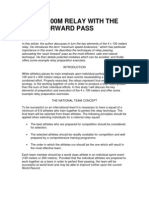Sprint Relay Exchanges
and
Speed Development
Chris Herriot
Arrowhead High School
herriot@ash.k12.wi.us
�Sprint Relay Exchanges
Sprint Relays
400M Relay
800M Relay
1600M Relay
Technical aspects
Various requirement for
individual legs
Psychological aspects ?
�Getting Started
Key Points
Rule #1The team that gets the BATON around
the fastest wins
Rule # 2 You wont get to use the 4 sprinters
you want to use
Rule # 3Someone will screw up. . . Make sure
they are ready
�400 METER RELAY
400M Relay
Traditionally
1st leg and Anchor
Fastest
Special Requirements
Refer to Rule #1
Block Skills
Running the Curve
Ability to work with
handoff partner
Nerves (can your
fastest kid take the
pressure of
anchoring)
Weak link
�Set up for First and
Second Runners
Key Points
Know the Zone
Acceleration
Zone?
Staggered in
Lane
1st Runner
must use Left
2nd Runner
must use Right
�400M Relay
Passing the baton
Closed exchange
Incoming runner
When to call stick
Aim for elbow then palm
Shoot arm straight forward
Outgoing Runner
Snatch vs layout
Check off point?
Hip check
Practice
Checking for speed
Make this part of your speed training
VIDEO! ! ! ! !
�800 METER RELAY
800M Relay
Traditionally
Treated like 400M
Relay
Special
Considerations
Block Skills
Wind
Indoor Vs
Outdoor
Consistency with
the stick
Weak link (less
room to play)
�Set up 1st and 2nd
800 M Relay
Outdoor
Where to start
Special
Considerations
Soft Release
Emergency Check
Point
Adjusting to the
inevitable
Practice
considerations
Indoor
Order
Exchanges
�1600M RELAY
1600M Relay
Promote the cult to the
4x4
Its an honor not a
punishment
Traditionally
1st leg and Anchor
Fastest
Special Considerations
Indoor Vs Outdoor
Competition
Do you have a kid who
would rather die than
lose? If yes he or she is
your anchor!
Preparing for #3
Rule # 3 in action
�1600M Relay
Passing the Baton
Open Exchange
Holding the Baton
Incoming Runner
Candle Stick
Out Going Runner
Three Step and Turn
Teach 2nd tangent at the break
Indoor
�Speed Training
Chris Herriot
Arrowhead High School
herriot@ash.k12.wi.us
�Personal Background
High School
Kettle Moraine
College
UW-Milwaukee/ UW La
Crosse
Arrowhead
Head Coach since 2003
�Background
�What constitutes a
speed workout?
When do you do one?
�Arent we all starting from scratch?
�Sprint Philosophy
If you want to race
fast you have to
train fast!
�Key Sprint Bio-motor Abilities
1.Flexibility
2.Coordination
3.Work Capacity
4. Strength
5. Speed
�Proper Form
Start with the
basics
Arm action
Shoot for 90
Hands
Drills
Stress at all times
��Proper Form
Dorsiflextion
Why is it
important?
Drills
Claw Drills
Draw In
Pelvic Tilt
Wall
Side lying
�Cycle Drill
�Proper Form acceleration
Improving
Acceleration
Form
Wall Drills
Keep Body in
straight line
Back leg and
front shin should
be at same angle
Speed harness
Face to Face
Drill
Never over resist
�Wall Drill
�Form Drills for Max V
A-Skips (Focus on Front side or Back
side mechanics)
Butt Kicks
Dont reveal the heal
Quick step alternating Butt Kicks
Fast Leg
Hurdles
March
Fast Leg
Ankling
Step over run
�Sample Form Drills
1. A-Skips
2. B-Skips
3. Alternating D. B.
Kick
4. Alternation S. B.
Kick
5. Butt Kick
6. Alternation D.B.
Kick
7. C-Skips
www.youtube.com/watch?v=nTRnyGe_wpk&feature=related
�Form Drills should be placed
in warm-up
Exercise
Neck Clock
Arm Hug
Arm Circles Micro/Mac
Hurdle Seat Change
Leg Swing Supine Alternate
Prone Scorpion
Rocker Half w/ Inside Hurdle
Leg Swing Sagital
Set
1
1
1 ea
1
1
1
1
1
Rep/Dis/Dur
5
5
5
5
5
5
5
8
Quadriceps Stretch Walk
Inverted Toe Touch
A Skip
Backward A Skip
1/2 Speed Build-Up
Knee Hug
Straight Leg March
Butt Kicks
Butt Kick Alternating Legs
3/4 Speed Build-Up
Elbow to Instep
Scale Walk
Fast Leg R
Fast Leg L
3/4 Speed Build-Up
Lung Walking
Leg Cradle
Ankling
Step Over Run
Full Speed Build-Up
1
1
1
1
1
1
1
1
1
1
1
1
1
1
1
1
1
1
1
4
20
20
20
20
20
20
20
20
20
20
20
15
20
20
20
20
20
20
20
50
See handout for full warm-up
�Speed Barriers
Avoid Bad Stereotypes
Always Stress FORM!
Excessive Speed Training
Trying to maintain max levels
for long periods of time (>10
sec)
Running Slow
Pace Workouts
�Speed Development Before Speed
Endurance
Begin Late fall Early Winter
Training
Workouts with Speed Component
Block Starts
Short Sprints over 20 to 40 M
sometimes 60
After new stereotypes of speed
are produced work speed
endurance (Beginning of Season)
�Stride Length and Frequency
How to Improve
Must change Central Nervous
System
Over Speed
Resistance Runs
Contrast Training
Resistance Assistance- Normal
Sled, Bungee, Flat
In and Outs
�Sample In and Outs
15/20-15/30-15/40-15/30-15/20-15
�Generating Workouts
How to set up Sprint Workout
Season
Start End of the Season
Plan every day of the season all at
once
Everything must be periodized
Running
Lifting
Use K.I.S.S method
�What is periodization
Periodization is simply
dividing an athlete's
training program into a
number of periods of time,
each with a specific
training goal or goals.
William H. Freeman Peak When it Counts
�What is the purpose?
To cause the Body to
continually adapt to new
conditions of overload and
to allow the muscles to
recover from the stress
of training.
�Periodization
�Training Load
Training load for sprinters is not simply found by adding up
the distance run. You must also incorporate the intensity
of the workout and the amount of rest
10 x 200 @ 30/ 2min rest = 2000M
compared to
8 x 200 @ 27/ 45 sec rest = 1600M
1600
May, 1500
1500
April, 1400
1400
1300
1200
W1
W2
March, 1100
1100
W3
1000
W4
900
800
700
March
April
May
June
��High School Weekly Plan
�Percentage Chart
200 Time
60%
65%
70%
75%
80%
85%
90%
95%
22.0
36.7
33.8
31.4
29.3
27.5
25.9
24.4
23.2
22.5
37.5
34.6
32.1
30.0
28.1
26.5
25.0
23.7
23.0
38.3
35.4
32.9
30.7
28.8
27.1
25.6
24.2
23.5
39.2
36.2
33.6
31.3
29.4
27.6
26.1
24.7
24.0
40.0
36.9
34.3
32.0
30.0
28.2
26.7
25.3
24.5
40.8
37.7
35.0
32.7
30.6
28.8
27.2
25.8
25.0
41.7
38.5
35.7
33.3
31.3
29.4
27.8
26.3
25.5
42.5
39.2
36.4
34.0
31.9
30.0
28.3
26.8
26.0
43.3
40.0
37.1
34.7
32.5
30.6
28.9
27.4
26.5
44.2
40.8
37.9
35.3
33.1
31.2
29.4
27.9
27.5
45.8
42.3
39.3
36.7
34.4
32.4
30.6
28.9
28.0
46.7
43.1
40.0
37.3
35.0
32.9
31.1
29.5
28.5
47.5
43.8
40.7
38.0
35.6
33.5
31.7
30.0
29.0
48.3
44.6
41.4
38.7
36.3
34.1
32.2
30.5
29.5
49.2
45.4
42.1
39.3
36.9
34.7
32.8
31.1
30.0
50.0
46.2
42.9
40.0
37.5
35.3
33.3
31.6
30.5
50.8
46.9
43.6
40.7
38.1
35.9
33.9
32.1
�Problems with Junior High
Season
Too short for major
adaptation
21 Days for training affect
Lack of access to Facilities
Days available for practice
Athletes at very different
levels of fitness
�Possible Solutions
Kids can do general endurance
workouts before the season
starts
Running can be done anywhere
Training can work on a three day
rotation
Workouts can be easily adapted
for all ability levels
�Possible Junior High Season
Monday
Wednesday
Friday
Intensive Tempo (AP)
Speed (S)
Extensive Tempo
Intensive Tempo (AP)
Speed (S)
Extensive Tempo
Intensive Tempo (AP)
Speed (S)
Extensive Tempo
Intensive Tempo (LAC)
Speed (S)/
Speed (AASE)
Speed Endurance (GSSE)
Intensive Tempo (LAC)
Speed (S)/
Speed (AASE)
Speed Endurance (GSSE)
Intensive Tempo (LAC)
Speed (S)/
Speed (AASE)
Speed Endurance (GSSE)
Intensive Tempo (LAC)
Speed (S)/
Speed Endurance (SE)
Pre-Meet
Intensive Tempo (LAC)
Speed (S)/
Speed Endurance (SE)
Pre-Meet
Intensive Tempo (LAC)
Speed (S)/
Speed Endurance (SE)
Pre-Meet
�4 week Junior High Season
Monday
Wednesday
Friday
Intensive Tempo (LAC)
Speed (S)/
Speed (AASE)
Speed Endurance (GSSE)
Intensive Tempo (LAC)
Speed (S)/
Speed (AASE)
Speed Endurance (GSSE)
Intensive Tempo (LAC)
Speed (S)/
Speed Endurance (SE)
Pre-Meet
Intensive Tempo (LAC)
Speed (S)/
Speed Endurance (SE)
Pre-Meet
�Sample High School Seasonal Breakdown
General
Preparation
Special
Preparation
Competition
Monday
Intensive Tempo
Intensive Tempo
Intensive Tempo
Tuesday
Speed- /Short Speed
Speed/ Short Speed
Endurance
Speed-Short Speed
Endurance
Endurance
Wednesday
Extensive Tempo
Extensive Tempo
Extensive Tempo
Thursday
Speed-
Speed- Short Speed
Special Endurance I
Aerobic
Alactic
Endurance
Anaerobic
Friday
Speed Endurance
Short Speed
Endurance
Special Endurance I
Warm-up
Light Speed (Sticks)
Saturday
Restoration
Restoration/
Competition
Restoration/
Competition
�Compatible Workouts
1. Endurance Runs and Strength
Endurance
2. Speed Development Runs and Speed
Strength development (jumping and
bounding)
3. Speed Development Runs and
explosive dynamic strength
developments exercise (Short jumps)
4. Speed Development runs with
movement coordination development
exercises (Starts, Sticks, form drills)
�Non-Compatible
1. Speed development with any type of
endurance runs over 80M
2. Speed development with strength
endurance development exercises.
3. Speed development with strength
development exercise (maximal
strength method)
4. Strength development (Maximal
Strength method) with any type of
endurance runs.
5. Exercise complexes for the
development of coordination with
strength development exercises.
�Time to Plan
Turn to the sample
Seasonal breakdown in
your packet
Use the Classification of
Energy System training
Chart to create a
Preiodized workout
�Parting Words
Good luck this
season!
Dont be afraid to try
something new.
�Tempo Endurance
-Very Important for 400M
-Helps Increase Oxygen Uptake
-Runs done at slower pace
-Emphasis should be quantity and
not quality
-Short 2 to 3 minutes
�Speed Endurance
Runs at 90 to 95% maximum
efforts
�Sample Seasonal Breakdown
General
Preparation
Special
Preparation
Monday
Intensive Tempo
Intensive Tempo
Tuesday
Speed- Short Speed
Endurance
Competition
Intensive Tempo
Speed/ Short Speed
Endurance
Speed-Short Speed
Endurance
Wednesday
Extensive Tempo
Extensive Tempo
Extensive Tempo
Thursday
Speed-
Speed- Short Speed
Special Endurance I
Aerobic
Alactic
Endurance
Anaerobic
Friday
Speed Endurance
Short Speed
Endurance
Special Endurance I
Warm-up
Light Speed
(Sticks)
Saturday
Restoration
Restoration/
Competition
Restoration/
Competition
�Sample Seasonal Breakdown
General
Preparation
Special
Preparation
Competition
Monday
Intensive Tempo
Intensive Tempo
Intensive Tempo
Tuesday
Speed- /Short Speed
Speed/ Short Speed
Endurance
Speed-Short Speed
Endurance
Endurance
Wednesday
Extensive Tempo
Extensive Tempo
Extensive Tempo
Thursday
Speed-
Speed- Short Speed
Special Endurance I
Aerobic
Alactic
Endurance
Anaerobic
Friday
Speed Endurance
Short Speed
Endurance
Special Endurance I
Warm-up
Light Speed (Sticks)
Saturday
Restoration
Restoration/
Competition
Restoration/
Competition
�Common
Terminology
Length of
Run
Component and
Description of
Objective
Percent of
Best
Performance
Rest
Interval
Between
Reps/Set
Volume range per session
100M 200M
MIN
MAX
MIN
MAX
Extensive
Tempo
>200M
AEROBIC CAPACITY (AC)
<69%
<45"/ <2'
1400
3000
1800
3000
Intensive
Tempo
>100M
>80
AEROBIC POWER (AP)
LACTACID CAPACITY
(LAC) Anaerobic Capacity
70-79%
80-89%
30"-90"/2-3'
30"-5'/3-10'
1400
800
1800
1800
1800
800
2400
2000
20-80M
SPEED (S) Anaerobic
Power
Alactacid Strength
90-95%
95-100%
3-5'/6-8'
3-5/6-8'
300
300
800
500
300
300
800
600
30-80M
ALACTIC SHORT SPEED
END. (ASSE)
Anaerobic Power
Alactacid Capacity
90-95%
95-100%
1-2'/5-7'
2-3/7-10'
300
300
800
800
300
300
800
800
<80M
Glycolytic
SHORT SPEED END.
Anaerobic Capacity
Anaerobic Power
90-95%
95-100%
1'/3-4'
1'/4'
300
300
800
800
300
300
800
800
80-150M
Lactacid Capacity
SPEED ENDURANCE
(SE) Anaerobic Power
Lactacid Strength
90-95%
95-100%
5-6'
6-10'
300
300
900
600
300
300
1200
600
Speed
Speed
Endurance















































































































